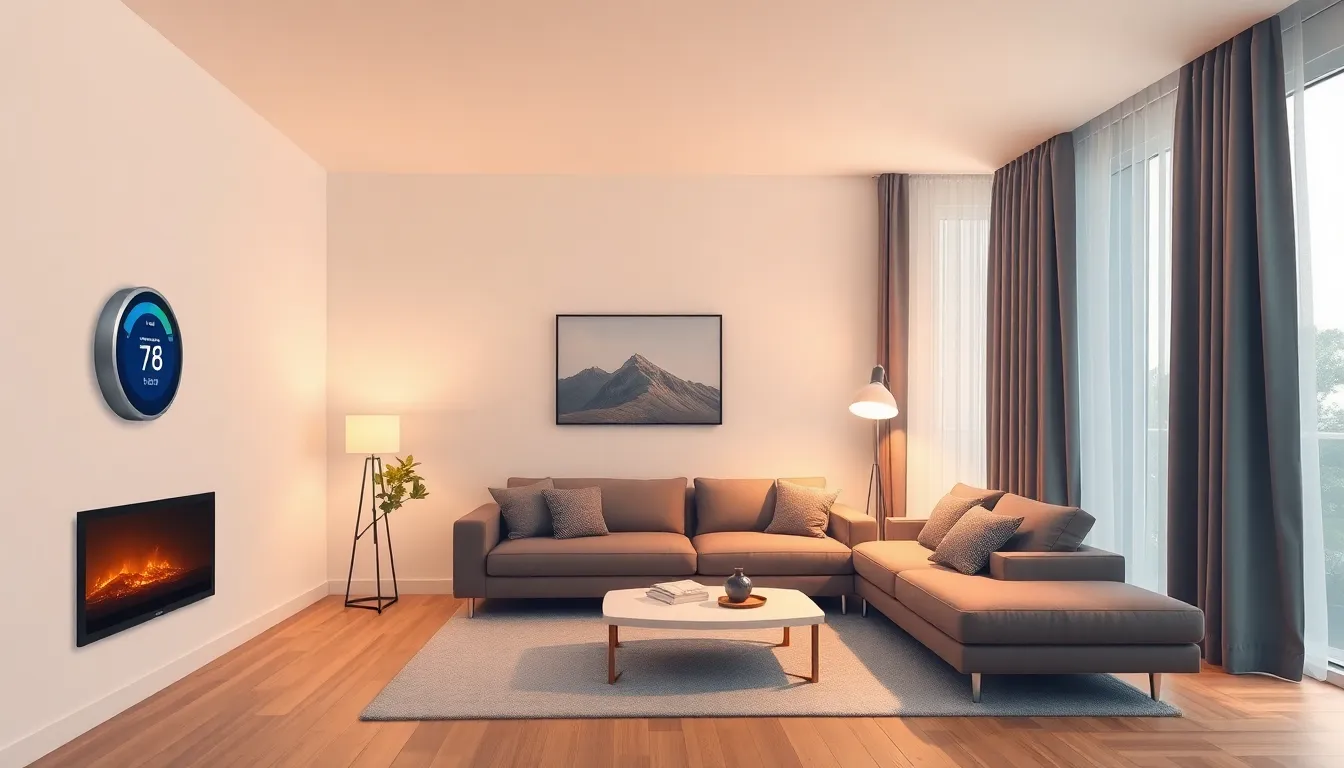In a world where your fridge can remind you to buy milk and your thermostat knows when you’re home, the Internet of Things (IoT) is more than just a tech buzzword—it’s a game changer. Imagine a life where everyday objects communicate seamlessly, making your home smarter and your life easier. With IoT, that dream isn’t just a sci-fi fantasy; it’s happening right now.
From smart cities that reduce traffic jams to wearable tech that tracks your health, the use cases for IoT are as vast as they are exciting. Businesses and consumers alike are discovering innovative ways to harness this technology, turning mundane tasks into automated wonders. So buckle up and get ready to explore how IoT is revolutionizing everything from agriculture to healthcare, one connected device at a time.
Table of Contents
ToggleOverview of IoT Use Cases
IoT use cases span various sectors, showcasing diverse applications that improve efficiency and user experience. In smart homes, devices like thermostats and lights operate intelligently, allowing homeowners to manage energy consumption and enhance comfort. Smart cities implement IoT sensors to monitor traffic flow, reducing congestion and improving public transport services.
Agriculture benefits from IoT with advanced monitoring systems that track soil moisture and crop health. Farmers utilize these insights to optimize resource usage, leading to increased yields and reduced waste. Healthcare applications also prove significant, with wearable devices enabling real-time health monitoring. Patients can share vital data with healthcare providers, allowing for timely interventions.
Manufacturing leverages IoT through predictive maintenance of machinery. Sensors provide data about equipment status, helping companies minimize downtime and reduce maintenance costs. Logistics similarly thrives on IoT, utilizing smart tracking systems to enhance supply chain visibility. Companies gain better control over inventory management and can respond swiftly to changes in demand.
Retail stores adopt IoT technologies for personalized shopping experiences. Smart shelves and customer analytics facilitate targeted marketing and inventory optimization. Each of these applications highlights how IoT drives innovation, enhancing operational efficiency and customer satisfaction across sectors.
Through diverse use cases, IoT continues to transform day-to-day operations, paving the way for smarter solutions that cater to evolving needs. As industries explore these technologies, the full potential of interconnected devices becomes increasingly evident.
Smart Home Applications

Smart home applications exemplify how IoT enhances daily living. By integrating technology throughout homes, various devices communicate seamlessly, improving convenience and efficiency.
Home Automation
Home automation streamlines control over household tasks. Thermostats monitor temperatures and adjust settings based on occupancy, which results in energy savings. Smart lighting systems enable users to modify brightness and color via mobile apps or voice commands, enriching the ambiance. Automated curtain systems respond to sunlight or user preferences, creating a comfortable atmosphere. These innovations contribute significantly to managing energy use and simplifying daily routines.
Security Systems
Security systems leverage IoT to provide enhanced protection. Smart cameras and doorbell systems offer real-time video feeds to homeowners, allowing for remote monitoring. Intruder detection sensors send alerts when unusual activity occurs, ensuring prompt responses. Smart locks enable keyless entry and can be controlled via apps, providing convenience and security. These technologies work together to create a safer living environment, reassuring homeowners about their family’s well-being.
Industrial IoT Use Cases
Industrial IoT (IIoT) significantly enhances operational efficiency and productivity across various sectors. Applications focus on automation, data collection, and streamlined processes.
Predictive Maintenance
Predictive maintenance uses IoT sensors to monitor equipment conditions in real-time. These sensors detect anomalies, predicting potential failures before they happen. By analyzing historical data, organizations can schedule maintenance only when necessary, reducing downtime. Companies report a decrease in maintenance costs and an increase in equipment lifespan. For example, a manufacturing plant using predictive maintenance technology saw a 20% reduction in unexpected outages. Data-driven insights make maintenance proactive instead of reactive.
Asset Tracking
Asset tracking leverages IoT solutions to provide real-time visibility into inventory and equipment locations. Sensors and GPS technology enable organizations to monitor assets throughout their lifecycle. Managers can retrieve information instantly, reducing loss and improving decision-making. For instance, logistics companies employing asset tracking systems cut operational costs by up to 15%. Enhanced visibility leads to better resource management and increased productivity. Integration with existing systems facilitates seamless workflows, enhancing overall operational efficiency.
Healthcare Innovations
IoT significantly enhances healthcare by enabling innovative solutions that improve patient outcomes and streamline processes.
Remote Patient Monitoring
Remote patient monitoring leverages IoT devices to track health metrics from a distance. Patients wear devices that monitor vital signs such as heart rate and blood pressure. This data transmits in real-time to healthcare providers, allowing for timely interventions. With consistent monitoring, professionals can detect health issues early, minimizing hospital visits. Many hospitals report improved patient engagement and satisfaction because of reduced travel for follow-ups. Analytics derived from collected data leads to personalized care plans that adapt to individual patient needs.
Smart Medical Devices
Smart medical devices transform traditional health practices into advanced, interactive experiences. Examples include connected insulin pumps and smart inhalers, which provide real-time feedback to users. These devices often integrate with mobile applications, enabling users to track their health data effectively. Consequently, healthcare professionals gain valuable insights to enhance treatment plans. For instance, smart glucose monitors help diabetic patients manage their conditions more accurately. Organizations adopting these technologies have witnessed increased adherence to treatment protocols and better health outcomes.
Smart Cities Initiatives
Smart cities leverage IoT technologies to enhance urban living. These initiatives focus on improving efficiency and quality of life through interconnected solutions.
Traffic Management
Traffic management systems use IoT sensors to optimize vehicle flow in urban areas. Real-time data collection helps identify congestion points and patterns. These systems enable traffic lights to adjust based on real-time traffic, reducing wait times. Innovative apps provide drivers with updated routing options, enhancing travel efficiency. Cities implementing these systems report a significant decrease in traffic jams, leading to lower emissions. Effective traffic management leads to safer roads and improved public transport services.
Waste Management Solutions
Waste management solutions incorporate IoT technology to streamline collection processes. Smart bins equipped with sensors monitor fill levels and notify collection agencies when they require servicing. This data-driven approach minimizes unnecessary pickups and reduces operational costs. Cities that embrace these solutions witness enhanced cleanliness and environmental sustainability. Analytics from waste collection data inform residents about recycling habits, promoting eco-friendly practices. Overall, smart waste management contributes to better resource allocation and sustainable urban environments.
Agricultural IoT Use Cases
Agricultural IoT applications significantly enhance farming practices, optimizing resource use and improving yields.
Precision Farming
Precision farming employs IoT technologies to monitor field conditions in real-time. Sensors placed across fields collect data related to soil moisture and nutrient levels. This information enables farmers to make informed decisions about irrigation and fertilization, targeting resources precisely where needed. Drones equipped with cameras also gather aerial imagery, helping identify crop health variations. By leveraging these insights, farmers reduce waste, increase productivity, and ultimately boost crop yields.
Livestock Monitoring
Livestock monitoring utilizes IoT devices to track animal health and behavior. Wearable sensors collect data on vital signs and movement patterns. This continuous monitoring allows farmers to identify potential health issues early, minimizing disease spread and improving animal welfare. RFID tags also assist in tracking location and managing livestock, enhancing operational efficiency. As a result, farmers can optimize feeding schedules and breeding practices, leading to healthier herds and increased productivity.
The Internet of Things is reshaping how individuals and industries interact with technology. Its diverse applications are not only enhancing everyday life but also driving efficiency and innovation across sectors. From smart homes to healthcare advancements and agricultural improvements, IoT is paving the way for smarter solutions that adapt to evolving needs. As connectivity continues to grow, the potential for IoT to transform various aspects of life remains limitless, promising a future where technology seamlessly integrates into daily routines and operations. Embracing these advancements will be crucial for those looking to thrive in an increasingly connected world.




